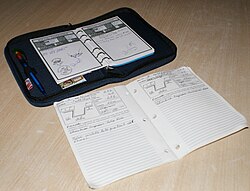

A logbook (or log book) is a record used to record states, events, or conditions applicable to complex machines or the personnel who operate them. Logbooks are commonly associated with the operation of aircraft, nuclear plants, particle accelerators, and ships (among other applications).
Contents
- Format
- Electronic logbooks
- Applications
- Maritime logbooks
- Shift logbooks
- Manufacturing logbooks
- Other applications
- See also
- References
The term logbook originated with the ship's log, a maritime record of important events in the management, operation, and navigation of a ship. The captain was responsible for keeping a log, as a minimum, of navigational wind, speed, direction and position.